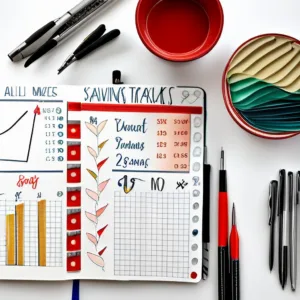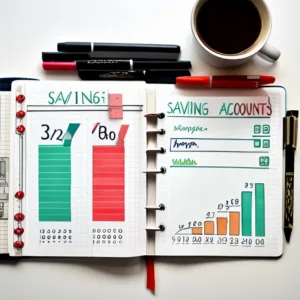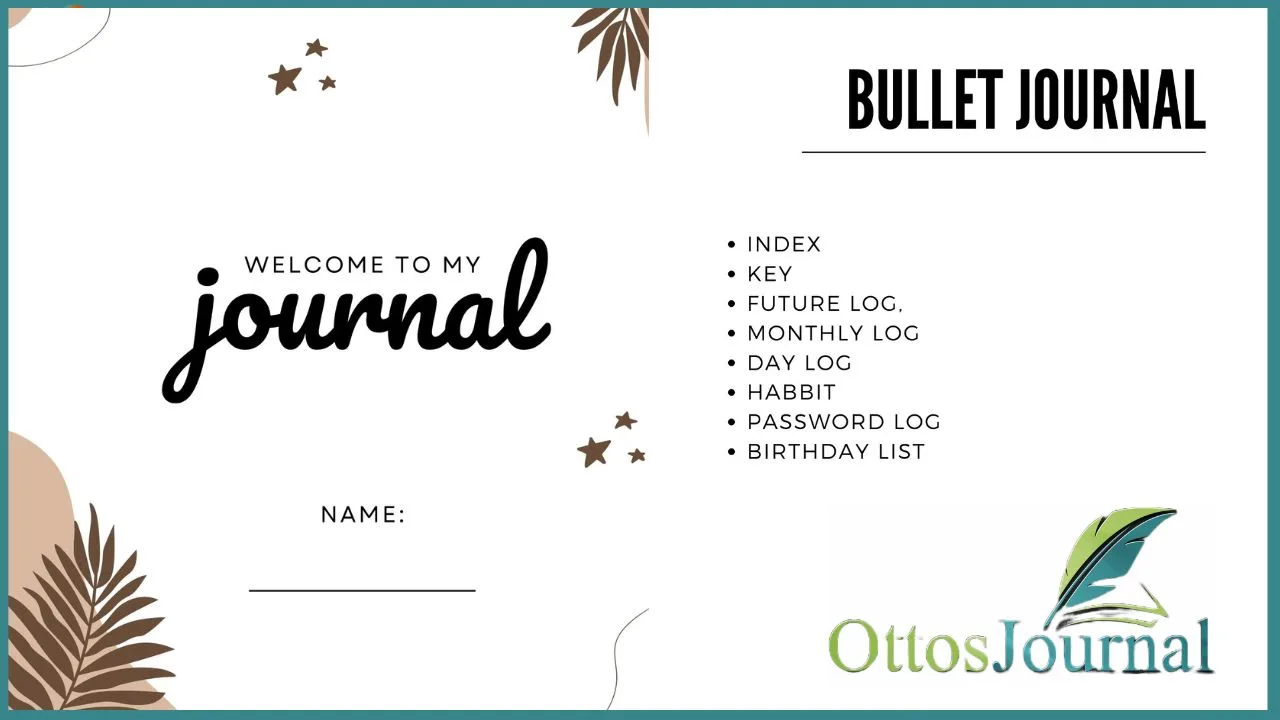Bullet journaling has become a popular way to stay organized and plan out your days, weeks, and months. But did you know it can also be a great tool for helping you save money? With the right spreads and trackers, bullet journaling can help you reach your financial goals and keep track of your spending. In this blog post, I will share with you 20 savings bullet journal ideas that will help you save money and stay on top of your finances.
20 Savings Bullet Journal ideas
Here are 20 savings bullet journal ideas to get you started:
Savings Goals Tracker Idea:
To establish a Savings Goals Tracker in your bullet journal, create a dedicated page with a clear goal heading. Utilize bullet journal budgeting tools like expense tracking and savings trackers to monitor your progress. Regularly update this page to stay focused on achieving financial success.

Monthly Savings Challenge Page Idea:
In your bullet journal, design a Monthly Savings Challenge Page with a catchy title and a fun way to visualize your savings goals. Incorporate bullet journal budget layouts to allocate funds for the challenge every month. This not only makes saving money enjoyable but also helps track savings efficiently.

Expense vs. Savings Pie Chart Idea:
Enhance your bullet journal’s financial tracking by creating an Expense vs. Savings Pie Chart. Use bullet journal expense tracker tools to categorize spending habits. Allocate a portion of the chart to showcase your growing savings, providing a visual representation of your budget distribution.

Emergency Fund Thermometer Idea:
Incorporate a visually appealing Emergency Fund Thermometer into your bullet journal. Track your progress by filling in the thermometer as you save money, ensuring your emergency fund steadily grows. This vivid representation serves as a constant reminder of your financial goals.

Debt Repayment and Savings Log Idea:
Create a dedicated page in your bullet journal for a Debt Repayment and Savings Log. Use bullet journal budget trackers to record credit card debt payments alongside your savings milestones. This consolidated log provides a holistic view of your financial journey, helping you manage both debt and savings effectively.

Savings Habit Tracker Idea:
Integrate a Savings Habit Tracker into your bullet journal to foster a consistent saving routine. Employ bullet journaling techniques to record daily savings activities. This tracker not only reinforces positive financial habits but also contributes to long-term financial success.

Interest Earnings Log Idea:
In your bullet journal, include an Interest Earnings Log to monitor the growth of your savings account. Use bullet journal budgeting tools to track interest earned over time. This log showcases the financial benefits of saving money in interest-bearing bank accounts.

Savings Challenges Spread Idea:
Enhance your bullet journal with a Savings Challenges Spread. Incorporate various savings challenges using bullet journal savings trackers. This interactive page not only makes saving money exciting but also encourages you to diversify your savings strategies for optimal financial growth.

Visualize Financial Milestones Idea:
Create a visually appealing page in your bullet journal to Visualize Financial Milestones. Use bullet journal ideas to represent your goals graphically. This serves as a motivational tool, reminding you of the progress made and inspiring further dedication to your financial objectives.

No-Spend Challenge Page Idea:
Integrate a No-Spend Challenge Page into your bullet journal to control expenses. Use bullet journal budget trackers to monitor spending during designated periods. This page promotes mindful spending habits, contributing to increased savings and financial discipline.

Savings Jar Tracker Idea:
Incorporate a Savings Jar Tracker into your bullet journal to mimic the traditional method of saving loose change. Utilize bullet journal savings trackers to visualize the gradual filling of your virtual savings jar. This creative approach adds a touch of fun to your savings routine.

Comparison of Savings Accounts Idea:
Enhance your financial decision-making by creating a Comparison of Savings Accounts page in your bullet journal. Utilize bullet journaling to list and compare different bank accounts, considering interest rates and features. This page assists in making informed choices for optimizing savings growth.

Financial Affirmations Page Idea:
Boost your financial mindset with a Financial Affirmations Page in your bullet journal. Incorporate positive affirmations using bullet journal ideas to reinforce a healthy relationship with money. This page serves as a daily reminder of your financial goals and encourages a positive money mindset.

Quarterly Savings Review Idea:
Implement a Quarterly Savings Review into your bullet journal for a comprehensive financial assessment. Use bullet journal savings trackers and expense tracking tools to analyze spending and savings trends over three-month intervals. This strategic review ensures ongoing financial success.

Savings Rewards Catalog Idea:
Make saving money exciting by designing a Savings Rewards Catalog in your bullet journal. Utilize bullet journal budget trackers to allocate rewards based on savings milestones. This creative approach provides an extra incentive to meet and exceed your savings goals.

Savings Challenges Reflection Page Idea:
After completing savings challenges, create a Savings Challenges Reflection Page in your bullet journal. Reflect on lessons learned and successes using bullet journaling techniques. This page aids continuous improvement in your savings strategies for ongoing financial growth.
Budget and Savings Wheel Idea:
Create a dynamic Budget and Savings Wheel in your bullet journal to visualize the distribution of income. Utilize bullet journal budget layouts to allocate funds for expenses and savings. This interactive wheel provides a clear overview, aiding in effective financial planning.
Savings Vision Board Idea:
Craft a visually inspiring Savings Vision Board in your bullet journal to manifest financial goals. Utilize bullet journal savings trackers and images that represent your aspirations. This creative tool serves as a daily reminder of your objectives, motivating consistent savings efforts.

Annual Savings Summary Idea:
Cap off the year with an Annual Savings Summary in your bullet journal. Use bullet journal budgeting tools to analyze yearly spending and savings patterns. This comprehensive overview facilitates informed financial decisions and sets the stage for future financial goals.
Savings Reflection Page Idea:
Conclude your bullet journal with a Savings Reflection Page to assess overall financial progress. Utilize bullet journal savings trackers and expense tracking tools to reflect on achievements and areas for improvement. This reflective practice fosters continuous financial growth.

What should be included in a budget journal?
In a comprehensive budget journal, essential elements include a bullet journal budget tracker to monitor expenses and income, a savings tracker to track progress toward financial goals, and a section to note any outstanding credit card debt.
Include personalized bullet journal budget layouts that suit your financial needs, incorporating bullet journal expense trackers for meticulous record-keeping. Utilize the journal for setting and reviewing short-term and long-term savings goals, creating a proactive approach to managing finances.
What are some ideas for a bullet journal?
Explore diverse bullet journal ideas such as incorporating a colorful layout, thematic spreads for each month, or a creative space for personal reflections. Use the journal for tracking daily tasks, goals, and habits, providing a holistic view of your life.
Experiment with unique bullet journaling tools like habit trackers, mood charts, or a dedicated space for inspirational quotes. Customizing your journal with these innovative ideas ensures it becomes a personal and effective organizational tool.
What do you write in a monthly bullet journal?
In a monthly bullet journal, record important events, deadlines, and appointments. Utilize a dedicated section for financial matters, integrating a bullet journal savings tracker to monitor progress.
Include a snapshot of your monthly budget, noting both income and anticipated expenses. Reflect on personal and professional goals, using the journal as a platform for self-improvement. The monthly spread should serve as a centralized hub for key information, fostering organization and clarity in your daily life.
What can I use instead of bullet journal planning?
While some prefer traditional bullet journals, alternatives include digital tools like budgeting apps or planners specifically designed for financial management. Explore apps that automate savings account tracking and provide real-time expense insights, offering convenience.
Specialized financial planners may also substitute for a bullet journal savings tracker, integrating features like goal-setting and progress visualization. Experiment with these alternatives to find the method that best suits your lifestyle and financial preferences.
What are the 2 most important items in bullet journaling?
The two pivotal components in bullet journaling are a meticulous bullet journal budget tracker and a dedicated savings tracker. These tools empower individuals to maintain a detailed record of daily expenses and income, fostering financial awareness.
The bullet journal expense tracker ensures accountability, while the savings tracker propels individuals toward achieving their financial goals. Together, these elements form a powerful duo, transforming the bullet journal into an indispensable tool for effective financial management.

What is dot grid journaling?
Dot grid journaling involves using a journal with pages featuring a grid of dots rather than lines or solid grids. This format provides structure without being intrusive, allowing for flexible layouts.
The dots serve as discreet guides, facilitating neat and organized designs. This style is particularly popular in bullet journals as it accommodates both written content and visual elements, offering a versatile canvas for creative expression and efficient planning.
Should bullet journal be dotted or grid?
Choosing between a dotted or grid format in a bullet journal depends on personal preference. The flexibility of a dot journal offers freedom in designing layouts, making it ideal for creative individuals.
On the other hand, a solid grid provides more structure, aiding in precise organization. Consider your planning style, if you prefer a balance between structure and flexibility, a dot journal might be the perfect choice for your bullet journaling needs.
What is index journaling?
Index journaling involves creating a comprehensive index or table of contents within your bullet journal. This feature enables easy navigation, allowing you to locate specific information quickly.
As you add content to your bullet journal, update the index with corresponding page numbers. This systematic approach enhances the journal’s functionality, transforming it into a dynamic reference tool. An organized index is particularly useful for tracking expenses, goals, and other vital information.
Is Dot journaling the same as bullet journaling?
While dot journaling and bullet journaling share similarities, they are distinct. Bullet journaling encompasses a broader organizational system that includes specific symbols for tasks, events, and notes.
On the other hand, dot journaling primarily refers to the use of dotted grids in a journal. While many incorporate dots into their bullet journal layouts, bullet journaling incorporates a more comprehensive system, encompassing task management, goal-setting, and reflection.
How far apart are bullet journal dots?
The distance between bullet journal dots depends on the specific journal’s design. Typically, dots are spaced at 5mm intervals. This standardized spacing allows for consistency and ease of use in creating layouts.
The 5mm distance strikes a balance, providing enough guidance for neat writing and drawing while maintaining a subtle appearance. When selecting a bullet journal, consider your preferences for spacing, as it can impact the overall aesthetic and functionality of your planning.
Which is better bullet journal or planner?
Choosing between a bullet journal and a traditional planner hinges on personal preferences and organizational needs. A bullet journal offers unparalleled flexibility, allowing users to customize layouts and incorporate various tools like bullet journal budgeting tools.
In contrast, a pre-designed planner provides structure, making it suitable for individuals who prefer a more straightforward approach to organization. Assess your lifestyle and planning style to determine whether the adaptability of a bullet journal or the structure of a planner better suits your needs.
How to do a bullet journal for beginners?
For beginners in bullet journaling, start with the basics. Create a simple yet effective bullet journal budget by incorporating a monthly savings tracker and an expense tracker. Experiment with straightforward layouts and gradually add elements like habit trackers and goal-setting pages.
Explore online resources and communities for inspiration and guidance on effective bullet journaling for beginners. Begin with a manageable approach, allowing the bullet journal to evolve organically based on your preferences and needs.
Bottom line:
Bullet journaling offers a versatile and customizable approach to financial management, making it ideal for individuals seeking organization and increased awareness of their expenses and savings goals. A bullet journal budget tracking and bullet journal savings tracker will help you keep track of your spendings. These journal savings tracker ideas can help you achieve your savings goal.
With numerous alternatives available, finding the right method for your bullet journal planning is simply a matter of preference and experimentation. Start with the basics, incorporate elements that work for you, and watch as your bullet journal transforms into an invaluable tool for managing your finances and achieving your goals.




